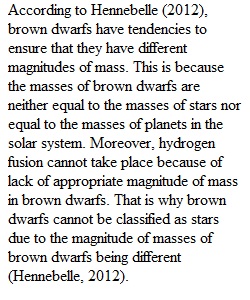


Q Find one or more recent article(s) from a reliable website or from a resource found in the APUS Library that discusses one of the following topics; summarize the article and elaborate on the topic: a. Describe Brown Dwarfs – what are they, why aren’t they classified as stars, what are the three classifications of them, and where do they fit on the H-R diagram (and indeed, should they even be included in the diagram?). b. What are “stellar nurseries” and protostars, and what advances have been made in discovering and studying them? c. Describe galactic cosmic rays and how they factor into long-duration human spaceflight (e.g., sending humans to colonize Mars). To receive full credit for the post, make sure you respond to at least two of your classmates (one classmate if the total number of students is four or less). If you post later in the week, check which topic your classmate(s) have chosen and pick a different topic to discuss. Your initial post should be at least 200 words.
View Related Questions